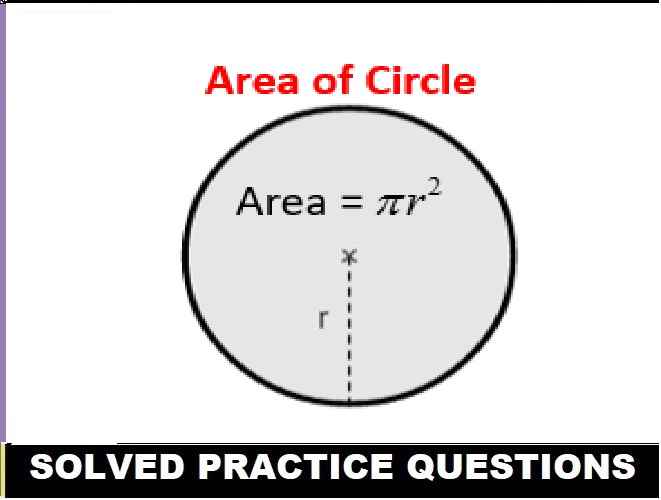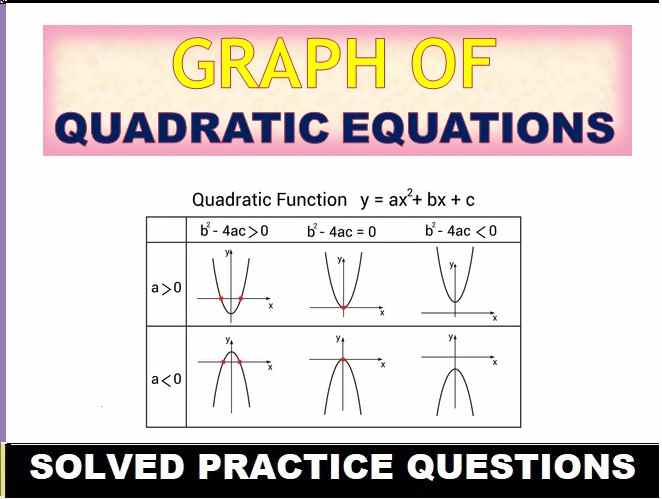Photosynthesis Class-10 long and Structured Goyal Brothers ICSE Biology Solutions Ch-6 . We Provide Solutions of long Answer Questions and Structured Questions Exercise-6 Photosynthesis. All solutions are given as council prescribe guideline for next upcoming exam. Visit official Website CISCE for detail information about ICSE Board Class-10 Biology.
Ch-6 Photosynthesis Goyal Brothers Prakashan ICSE Class-10 Biology Solutions
| Board | ICSE |
| Publications | Goyal Brothers publications |
| Subject | Biology |
| Class | 10th |
| Writer | Dr. K.K. Aggrawal |
| Chapter-6 | Photosynthesis |
| Topics | Solutions of Long Answer Type Questions and Structured Questions |
| Edition | for 2022-2023 Academic Session |
Note :- Before Viewing Goyal Brothers Solutions of Chapter-6 Photosynthesis. Read the whole chapter carefully with figure. Make a self written notes including Phases of Mitosis.
D. LONG ANSWER TYPE QUESTIONS
Ch-6 Photosynthesis Goyal Brothers Prakashan ICSE Class-10 Biology Solutions
(Page-86)
Question 1. Draw a neat and well labelled diagram of the chloroplast.
Answer:
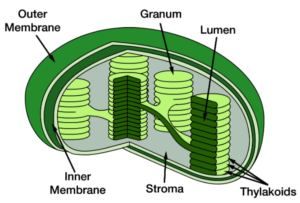
Question 2. List the events taking place in the photo-chemical phase of photosynthesis.
Answer:
The photochemical phase of photosynthesis is light-dependent. A series of chemical reactions occur in quick succession initiated by light, therefore the phase is called photochemical phase. It takes place in chlorophyll-containing thylakoids of chloroplast.
It occurs in the following steps :
- The chlorophyll on exposure to light energy becomes activated by absorbing photons.
- This energy is used in splitting the water molecules (photolysis) as below:-
H2O ——> H+ + OH– - OH– ions through a series of steps produce water (H2O) and oxygen (O2). Water may be used inside the plant but O2 released into the atmosphere.
- H+ combines with CO2 in dark reaction to produce glucose.
Question 3. If you are planning an experiment to show the effect of light on photosynthesis :
(a) Will you select white light or green light? Justify your answer.
(b) Why would you select a destarched plant?
Answer:
(a) I will select white light because photosynthesis is maximum in white light while it is minimum in green light as green light is reflected by green plants
(b) It is necessary to destarch a plant before performing photosynthesis experiment because the amount of starch formed during the experiment should be validated. I will select destarched plant so that I can demonstrate the synthesis of starch through iodine test.
Question 4. Give the reason:
(i) Green leaves are thin and broad.
(i) Photosynthesis is is considered as a process supporting all life on earth.
Answer:
(i) Green leaves are thin and broad to increase the surface area for absorption of light and carbon dioxide
(ii) Photosynthesis is considered as a process supporting all life on earth. Answer: This process produces food and releases oxygen, both of which are necessary to maintain life on earth
Question 5. Why do the leaves have upper surface more green and shiny than the lower layer?
Answer:
A dorsiventral leaf is differentiated into upper and lower surface, the upper surface is more green and shiny because it has a waxy coating to prevent loss of water due to evaporation
Question 6. Describe the chemical changes which occur during photosynthesis in
(a) Light reaction
(b) Dark reaction
Answer:
(a) The light reaction occurs in two main steps: (1) Activation of chlorophyll – On exposure to light energy, chlorophyll becomes activated by absorbing photons. (2) Splitting of water – The absorbed energy is used in splitting the water molecule into hydrogen and oxygen, releasing energy.
(b) In the dark reaction, ATP and NADPH molecules (produced during light reaction) are used to produce glucose (C6H12O6) from carbon dioxide. Fixation and reduction of carbon dioxide occurs in the stroma of the chloroplast through a series of reactions
Question 7. Draw the diagrams of a food chain. Name the biological process at the starting point. Explain how all the animals are dependent on it?
Answer:
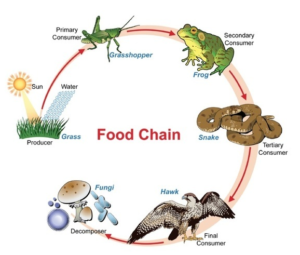
The food chain starts with the producer (See figure) and ends with the consumer. The producer is an organism that makes food i.e. synthesizes its own food. Green plants can make their own food by the process of photosynthesis. Thus, all food chains begin with producers i.e. green plants.
E. STRUCTURED QUESTIONS
Ch-6 Photosynthesis Goyal Brothers Prakashan ICSE Class-10 Biology Solutions
(Page-86)
Question 1. The figure given below represents an experiment to demonstrate a particular aspect of photosynthesis. The alphabet ‘A represents a certain condition inside the flask.
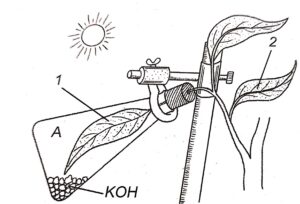
(i) What is the aim of the experiment?
(ii) Identify the special condition inside the flask.
(iii) Name an alternative chemical that can be used instead of KOH.
(iv) In what manner do the leaves 1 and 2 differ at the end of the starch test?
Answer :
(i) The aim of the experiment is to show that C02 is necessary for photosynthesis.
(ii) The leaf inside the flask do not turn blue black when tested with iodine.
(iii) NaOH (Sodium hydroxide) can be used as an alternative.
(iv) ) Leaf 1 does not turned blue black while leaf 2 turned blue black at the end of starch test,
Question 2. The diagram given below is an experiment conducted to study a factor necessary for photosynthesis. Observe the diagrams and then answer the following questions :
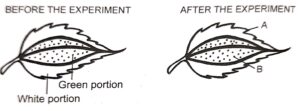
(i) What is the aim of the experiment ?
(ii) Name the test performed on the leaf and the solution used for the test.
(iii) What type of leaf was used for the experiment ? Give an example.
(iv) What is the exported result of the above test on the parts labelled A and B ?
(v) Give a balanced chemical equation to represent the process of Photosynthesis.
Answer:
(i) To show that chlorophyll is necessary ku photosynthesis.
(ii) Starch test.
Solution used in Iodine solution.
(iii) Variegated leaf/Coleus leaf (leaf having non green and green regions).
(iv) After performing starch test,
Part A turns blue black with Iodine solution.
Part B turns brown with Iodine solution Sunlight
(v)
Question 3. Given below is a diagrammatic representation of the internal structure of an organelle found in a plant cell. Study the same and then answer the questions that follow:
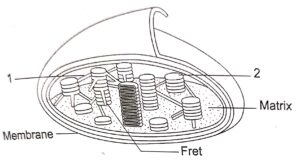
(i) Identify the organelle.
(ii) Name the physiological process occurring in this organelle.
(iii) Mention one way in which this process is beneficial to man.
(iv) Name the phases of the process occurring in the part labelled ‘1’ and 2.
(v) A chemical substance ‘NADP” plays an active part in one of the phases. Give the expanded form of NADP and state its role in the above process.
(vi) Represent the physiological process mentioned in (i) above in the form of a chemical equation.
Answer :
(i) Chloroplast.
(ii) Photosynthesis.
(iii) It is a process supporting all life on earth. All animals including man, ultimately depend on plants for food as every food chains have just one starting point, i.e., plants the producers.
(iv) The process occurring in the part labelled ‘1’ is ‘dark reaction or biosynthetic reaction or Calvin cycle’.
The process occurring in the part labelled ‘2’ is ‘Light Reaction or Photochemical reaction or Hill reaction’.
(v) The expanded form of NADP is Nicotinamide Adenine dinucleocide phosphate.
NADP is reduced to NADPH by accepting one electron. Now this NADPH in the dark reaction transfers its hydrogen through a series of chemical reactions to combine with CO2 to produce C6H12O6 by using energy from ATP.
(vi)
![]()
Question 4. The diagram given below represents an experiment conducted to prove the importance of a factor in photosynthesis.
Study the same and then answer the questions that follow:
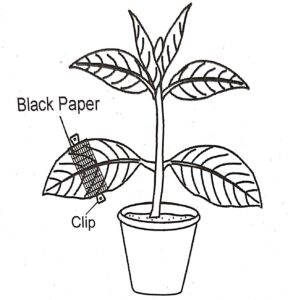
(i) Name the factor being studied in this experiment.
(ii) Why was the plant kept in a dark room before conducting the experiment?
(iii) Why was the experimental leaf then kept in –
(a) boiling water
(b) methylated spirit?
(iv) Name the solution used to test for presence of starch in the leaf.
(v) What will we observe in the experimental leaf at the end of the starch test?
(vi) Give a balanced chemical equation to represent the process of photosynthesis.
Answer :
(i) Sunlight
(ii) Plant is kept in a dark room before conducting the experiment, to destarch it.
(iii) 1. In the boiling water, it was kept to kill the cells.
2. In the methylated spirit, it was kept to dissolve the chlorophyll.
(iv) Iodine is used to test for presence of starch in the leaf.
(v) On treating the leaf with iodine solution it shows that the portion of leaf covered with the strip of black paper does not give positive test for starch. The covered portion of leaf indicates the absence of starch after iodine test because it could not get light to perform photosynthesis. Hence it is proved that in the absence of light the leaf can not manufacture the starch.
(vi)
Question 5. The figure given below represents an experimental set-up to study a physiological process in plants:
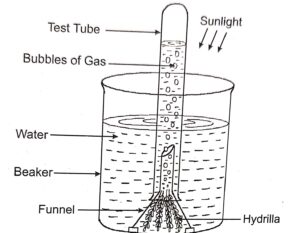
(i) Name the physiological process being studied.
(ii) Explain the process.
(iii) What is the aim of the experiment ?
(iv) Give a wall balanced equation to represent the process.
Answer :
(i) The physiological process being studied is photosynthesis.
(ii) It is the process by which green plants manufacture glucose from carbon dioxide and water which they get from atmosphere and soil respectively.
(iii) The aim of the experiment is to find out that oxygen is given out during photosynthesis.
(iv) ![]()
Question 6. A potted plant was taken in order to prove a factor necessary for photosynthesis. The potted plant was kept in the dark for 24 hours. One of the leaves was covered with black paper in the centre. The potted plant was then placed in sunlight for a few hours.
(i) What aspect of photosynthesis was being tested ?
(ii) Why was the plant placed in the dark before beginning the experiment ?
(iii) During the starch test why was the leaf:
(1) boiled in water.
(2) boiled in methylated spirit.
(iv) Write a balanced chemical equation to represent the process of photo-synthesis.
(v) Draw a neat diagram of a chloroplast and label its parts.
Answer :
(i) Sunlight is necessary for photosynthesis.
(ii) To make the leaves free from starch.
(iii)
1. To kill the cells.
2. To remove the chlorophyll.
(iv) ![]()
(v) 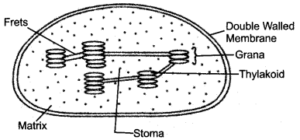
Question 7. The diagram given below shows two test-tubes A and B. Test-tube A contains a green water plant. Test-tube B contains both a green water plant and a snail. Both Test-tubes are kept in sunlight. Answer the questions that follow :
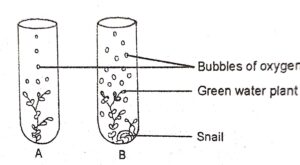
(i) Name the physiological process that releases the bubbles of oxygen.
(ii) Explain the physiological process as mentioned above in Q. 2. (a) (i).
(iii) What is the purpose of keeping a snail in test-tube ‘B’ ?
(iv) Why does test-tube ‘B’ have more bubbles of oxygen ?
(v) Give an example of a water plant that can be used in the above experiment.
(vi) Write the overall chemical equation for the above process.
Answer :
(i) Photosynthesis.
(ii) It is a process in which green plants (plant cells having chlorophyll) take in carbon-di-oxide and water in presence of light to produce glucose and release oxygen gas.
(iii) So that snail can release carbon di oxide into the water for plant.
(iv) Rate of photosynthesis is more in test tube B because the plant in B gets more C02 from the snail.
(v) Hydrilla.
(vi) ![]()
Question 8. The following diagram demonstrates a physiological process taking place in green plants. The whole set up was placed in bright sunlight for several hours. Study the diagram and answer the questions that follow :
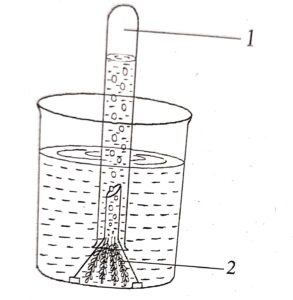
(i) What aspect of the physiological process is being examined ?
(ii) Explain the physiological process mentioned in (i) above.
(iii) Label the parts numbered 1 and 2 in the diagram.
(iv) Write a well balanced chemical equation for the physiological process explained in (ii) above.
(v) What would happen to the rate of bubbling of the gas if a pinch of sodium bicarbonate is added to the water in the beaker ? Explain your answer.
Answer :
(i) Photosynthesis.
(ii) The process in which plant cells having chlorophyll take raw materials like carbon dioxide from air & water from soil and manufacture glucose in presence of light. Oxygen is a waste product during this process.
(iii) Part 1 – Oxygen gas.
Part 2 – Hydrilla plant.
(iv) ![]()
(v) Rate of bubbling of gas suddenly increases on adding a pinch of sodium bicarbonate.
Sodium bicarbonate releases carbon dioxide into the water which is made available to the plant. This increases the rate of photosynthesis. So more oxygen is released thus more bubbles released.
Question 9. The diagrams given below represent the relationship between a mouse and a physiological process that occurs in green plants. Study the diagrams and answer the questions that follow:
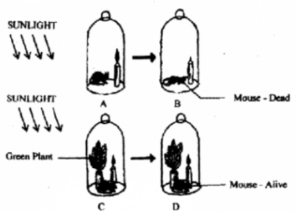
(i) Name the physiological process occurring, in the green plant that has kept the mouse alive.
(ii) Explain the physiological process mentioned above.
(iii) Why did the mouse die in bell jar B?
(iv) What is the significance of the process as stated in (i) for life on earth?
(v) Represent the above mentioned physiological process in the form of a chemical equation.
Answer :
(i) photosynthesis.
(ii) Photosynthesis is the process by which h green plants in the presence of sunlight and chlorophyll prepare food in the form of carbohydrates using carbon dioxide and water.
(iii) Mouse died in hell jar B because the source of oxygen i.e, the green plant was missing and the oxygen present in the bell jar was utilized in burning of candle.
(iv) Photosynthesis provides food and balances the oxygen and carbon cycle in the atmosphere.
Chlorophyll
(v) ![]()
— : End of Photosynthesis Class-10 Long and Structured Questions Goyal Brothers Solutions :–
Return to :- ICSE Biology for Class 10 Goyal Brothers Prakashan solutions
thanks
